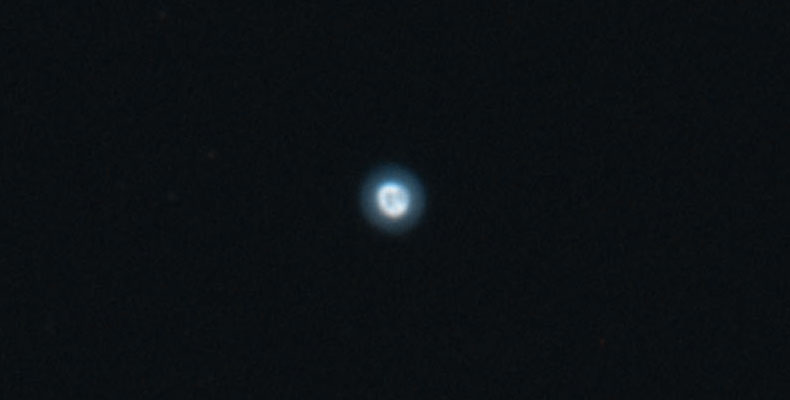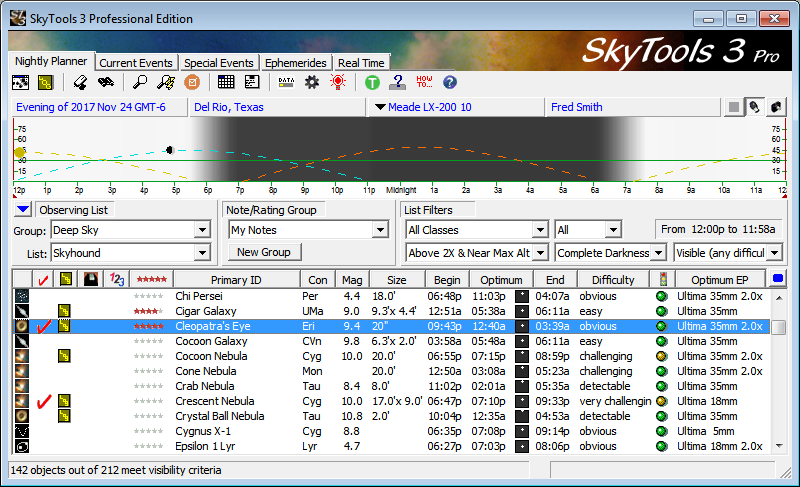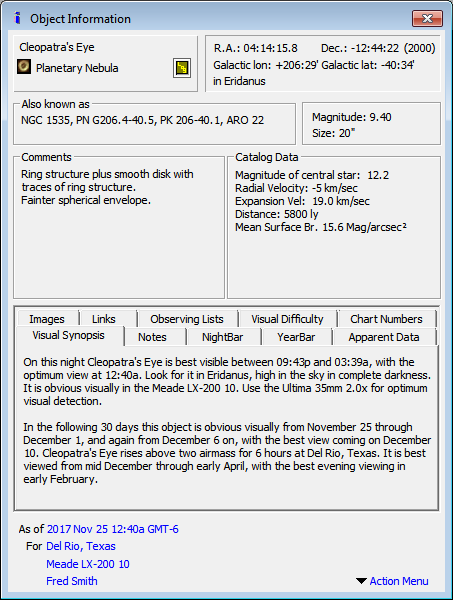

I
took this image of NGC 1535 with iTelescope
T32. It is a color composite made
from 2x3min exposures in the OIII and H-alpha filters. The OIII was
mapped to blue and the H-alpha to red. Green was synthesized as a
combination of the two. The OIII line is the stronger, thus the
blue-green color.
|

The field in a six-inch at 50x. North is down and east is right. |
Visually, NGC 1535 is my all-time
favorite planetary nebula. Although a fine object for small
telescopes, it really shines in large aperture instruments.
As a small, very high surface brightness object,
it takes
magnification extremely well. So for the best view, it is
important to use as much
magnification as the conditions will permit. Make sure it is
high in the sky. If the seeing is poor, come back on
another night and try again. It really is worth getting a
good look.
 In
my six-inch, this planetary is obvious at 50x. It appears very
bright. My best view is at 270x, where it appeares as an
elongated disk with a visible central star. The image
on the right closely resembles the appearance of NGC 1535 in small
telescopes. In
my six-inch, this planetary is obvious at 50x. It appears very
bright. My best view is at 270x, where it appeares as an
elongated disk with a visible central star. The image
on the right closely resembles the appearance of NGC 1535 in small
telescopes.
|
My first view of NGC
1535 in a large- aperture instrument came with the first light of my
18" Dob way back in October 1999. At 166X it appeared
little different from the view in my 6-inch. I logged the
following, "Nearly round. Very bright. Fuzzy edges."
When I inserted a 2X Barlow
for another look I was stunned. Here is my log from
that night and a drawing of what I saw (left):

"As it came into view I was astonished, like seldom before.
"Oh my God", I said out loud to the darkness. This
was no visual observation of a planetary nebula. It was a
photograph! Very bright, with a non-stellar appearing central
"star" with sharp edges. Some dark surrounding this,
then a bright, slightly oval ring -- quite distinct. All this
embedded in a slightly oval, sparkling haze."
This is a wonderful object that I felt should have a
memorable and descriptive name. I dubbed it "Cleopatra's Eye", in reference to the oblong inner ring
that surrounds the central star. It is gratifying that as a
result of my original post many years ago, this name has found
some acceptance in the visual observing community. Planning
Your Own Observation

Many
more columns are available, but we had to squeeze things to fit
our space here.
The
SkyTools Nightly Planner is set up above for November 24, at Del Rio Texas,
with a 10-inch LX200. Cleopatra's
Eye is selected. The graphic at the top shows the darkness of the
sky during the night. The red dashed line is the altitude of Cleopatra's
Eye. The teal line is the altitude of the moon, which you can see
sets at about 23:00 (11 PM). The green horizontal line is an
altitude of 20 degrees above the horizon, below which you are
looking through more than twice as much air as overhead. So you
want to observe above this line. We can see that our best view
will be from about 10:00 PM to 3:30 AM, when our object is highest in
a dark sky, and this is reflected in the times listed in the Begin,
Optimum, and End columns. These times are computed
for when the contrast is maximized. Because of the high surface
brightness of our target, the phase of the moon, and its
separation in the sky, SkyTools calculates that we can still get a
good view even when the moon is still up. The very best view will
be at 12:40 AM.
Other software may do
something similar, but they only make generic claims for your
telescope, rather than specific calculations for an actual night
under actual observing conditions, including the altitude and
phase of the moon and level of light pollution. On
another night, SkyTools may say that the object is difficult to
see in the eyepiece rather than obvious.
 When
we right-click on our object we have options: to see everything
SkyTools knows about it (right), to view in it the Atlas,
view/print a finder chart, slew your telescope, create/view log
entries, download a DSS image, etc. The time is automatically
selected to be the optimum time to view. When
we right-click on our object we have options: to see everything
SkyTools knows about it (right), to view in it the Atlas,
view/print a finder chart, slew your telescope, create/view log
entries, download a DSS image, etc. The time is automatically
selected to be the optimum time to view.
Click
below to see a full size finder chart that was made by
right-clicking on the object in the planner.

This
finder chart is for an 8-inch Dob. The
left side shows the naked-eye sky with Rigel QuikFinder
circles at the location of the object. On the right is the view in
a wide field eyepiece. The orientation and magnitude limits are
properly calculated for the time and location, including light
pollution, twilight, and moonlight. As a result, it is a simple
matter to find this tiny planetary. Once centered, insert a
higher-power eyepiece. A version of the same chart
can be printed and taken into the field.
Greg Crinklaw — Developer of
SkyTools
SkyTools
3, because the astronomy matters.
Read
more about SkyTools 3
|